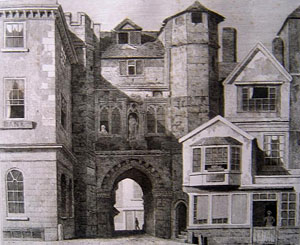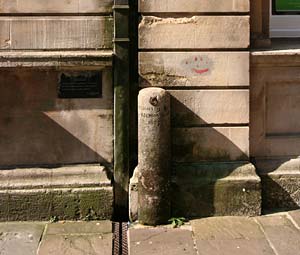
Broadgate
Also known as St
Michael's Gate, this was the main
entrance gate to Cathedral Close, and dates from 1286. Although it
was one of the three widest gates leading into the close, it was still
only 3 meters wide. In the 16th century, Hooker noted that it was
sometimes called Fissand, meaning a narrow fissure. In the early 19th
century, just before it was demolished it was described as a filthy
quagmire. Like many gates in the city, it had accommodation built in -
Broadgate was used for housing members of the cathedral staff
including the main gatekeeper for the close, whose duties included
removing undesirables, including females, from the close at night. In
1815, it was also the residence of the Cathedral Scavenger, who cleared
animal dung and rubbish, and the Lamplighter.
In 1778 several images of Roman gods were said to have been found
under a house at Broadgate, indicating that there had been a Roman
household shrine at that spot. Edward Upham occupied a shop at
Broadgate in 1801 when he offered Cary's New English Atlas for
sale.
Although one of the widest of the
seven gates, it started to prove to
be a hindrance to stage coaches entering the close heading to the
Royal Clarence Hotel. The manager of the hotel petitioned the Cathedral
authorities in the early 19th century to have the gate removed
after a coach had hit the side of the gate, resulting in the horses
panicking and breaking away to gallop along the road to the Royal
Clarence leaving the passengers stranded. By 1823 plans were afoot to
deal with Broadgate, and a letter in the Flying Post from "One of the Old School" expressed
the view that the old gate should not be vandalized, but should be
preserved.
On 28th December 1824 the gate was demolished and widened in
1833.
Nowadays, we always think of Broadgate as the short street between Cathedral Close and the High Street. The old Tinley's teashop, now Pizza Express, occupies one corner of the old gate and has part of the original wall erected in 1286. Posts, marking the position of the gate, were installed soon after its demolition so that the Cathedral authorities could continue to claim jurisdiction over the Close. When Prince Charles visited in 1979, a ribbon was tied between the posts to symbolically represent a chain, which was once used to close Cathedral Close off with a chain, after the gate was removed. Also see Broadgate in streets.
 Broadgate
from inside Cathedral Yard - demolished in 1825.
Broadgate
from inside Cathedral Yard - demolished in 1825.
 The post marks the boundary of the
old Broadgate. The ring is used to
hold a chain across the road.
The post marks the boundary of the
old Broadgate. The ring is used to
hold a chain across the road.
│ Top of Page │